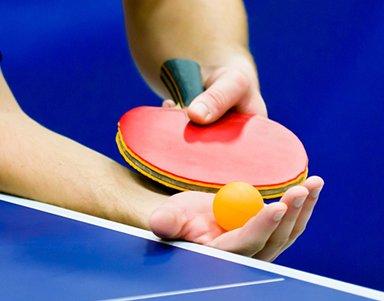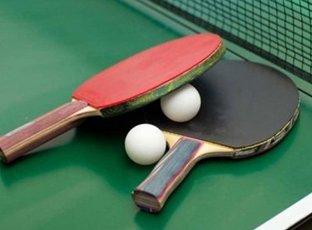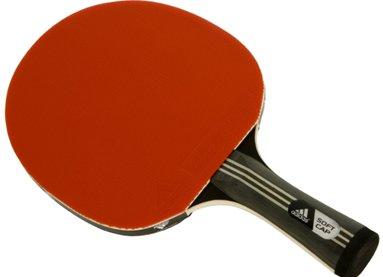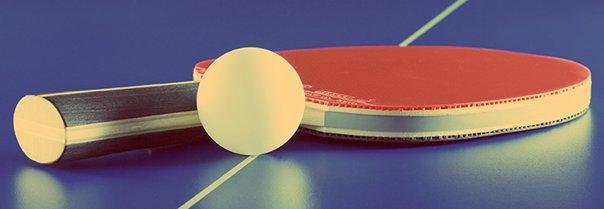Table tennis is considered one of the most popular sports games. It has long been popular with a large audience and is officially recognized, which is confirmed by its inclusion in the program of the Olympic Games. In addition, they organize various sports events and competitions for people regardless of gender and age. Due to its simplicity, accessibility and health benefits, table tennis attracts new participants every year. It is imperative to have a quality racquet to perform at the appropriate level. To know how to choose a table tennis racket, you should read the recommendations.
Content [Hide]
The principle of operation and structure of the table tennis racket
The table tennis racket is the main instrument through which the game is carried out. The style, speed and conduct of most of the key elements will directly depend on it.
It consists of a base, a handle and rubber pads with a sponge. They are made mainly of wood, which is connected in several layers. Titanium and carbon complete the composition. On a flat and even surface, a patch is glued, which has pimples. It is necessary that the base is not less than 85% wood.
Rackets are sold individually and in sets of 3-5 pieces, which will make it possible to play with a large company. Professional players buy the base, rubber and special glue separately so that they can assemble the required fixture themselves.
The sport in question provides an opportunity to develop health, as well as intellectual abilities. During the game, the participant will actively move and think. During the game, psychostability will be developed, concentration of attention, reaction and so on will be increased.
This kind of sport will have a positive effect on the functioning of the respiratory tract and the heart with blood vessels. Muscles will be in good shape, coordination will improve. Tennis is recommended for virtually all age groups and has no particular contraindications.
Table Tennis Racket Selection Options
The question often arises of how to choose the right quality table tennis racket. Initially, choosing a table tennis racket is not difficult. However, in fact, even professional athletes will experience certain difficulties, getting lost in a wide variety of types of bases and overlays.
Base

The most important element is the base. She will be responsible for maneuvers and speed. Often made from several layers of wood of various species. They can be glued together and dried under the press. A high quality base will guarantee fast and easy learning and skill improvement:
- Wood. The most common type of raw material used for the production of the substrate. Mostly they use plywood or multi-layer veneer (2-9 layers) of coniferous wood.Balsa (wood species) is considered more expensive, but at the same time light and with better rebound parameters. The tree is characterized by a high-quality rebound and a proper vibration sensation, which is transmitted to the athlete's hand during the reception. In addition, only a racket with a wooden base can be played at a professional tournament (it has the corresponding ITTF mark). But the base of wood can deteriorate from water, therefore they will not be able to play in dampness and rain in the air.
- Plastic. Plastic bases will not be afraid of water, therefore they can be played in the air even in light rain. Unlike wood products, they will not delaminate and actually have durability. They will perfectly withstand drops and hits on the table, therefore they will be an excellent solution for a child. Polymer rackets have a striking design - especially suitable for women. But the parameters of bounces and reception in them are much worse than in the tree, therefore they are suitable only for beginners. Professionals should focus on wood models.
- Carbon fiber inserts. Carbon fiber inserts make it possible to increase the attacking parameters of the base and reduce its mass. They are able to be found in models made of wood and in plastic bases, ready-made and prefabricated rackets. However, when carbon inserts are not too important for wooden bases (the parameters of speed, handling and control are maximum), then in plastic they will significantly increase the playing parameters. Therefore, when the difference in cost between plastic and plastic with carbon fiber is not significant for the user, then the second should be taken.
The following types of bases are distinguished:
- DEF - defensive play;
- ALL - passivity in the game;
- ALL- - versatility in the game;
- ALL + - attack;
- OFF- - medium attack;
- OFF - direct hit with force, considerable speed and circulation;
- OFF + - stubborn play with high attack speeds.
Overlays
They are special rubber plates that are attached with glue to the base on each side. May be smooth and pimpled. They will be responsible for the speed of circulation, serve and control of the ball. Linings, taking into account the skill of the tennis player and the manner of play, can be:
- Various - for active play. On one side there is a smooth surface, on the other it is studded. During the service, during the game, turn over with the required overlay. There may be variations for destruction and attack. The sides often change throughout the game.
- Identical - 2 smooth, similar in appearance. According to individual parameters, 1 is faster, 2 - gives better rotation. In a match, they basically do not turn over.
- Attacker - a racket that has a smooth pad on the right side and anti-spin or long pimples on the left. It is intended to “destroy” the opponent's play. By means of the attacking model, it is possible to change the pace of the game or to give a difficult flight path. Such a product is turned over during the whole match.
Divide into lining thickness:
- 1.6-1.8 mm is an excellent solution for a station wagon. Adequate control of counterattack, undercutting, topspin, stand.
- 1-1.5mm - Precise counters and stands, trims with proper control.
- 2 mm is the greatest thickness. An attacking game with varying degrees of difficulty and speed.
A pen
The handle affects the comfortable position of the racket in the hand. A properly selected one will not slip and rub the skin. The shape of the handle will make it possible to quickly master the game and improve skills. Often the choice will depend on the player's grip. The following types of handles are distinguished:
- Straight - Used by players who flip the racket when playing the ball.
- Flared - inconvenient for turning the racket or changing grip while playing.
- Conical - middle solution between flared and straight.
- Concave - Recommended for an experienced player, as it is inconvenient for a quick turn or change of grip while playing.
- Anatomical - suitable for beginners, since the hand will get tired less even after a long game.
Weight
To keep the hand from getting tired, the table tennis racket should not be massive. At the same time, weightless is also not suitable, as it catches unnecessary vibration, which interferes with proper control, which affects the overall result of the game. The optimal weight of the product with rubber pads is in the range of 150-200 g.
The best manufacturers of table tennis rackets - which company to choose

Table tennis rackets are produced by various sporting goods developers. However, experts advise buying them from internationally renowned manufacturers. Basically, such brands specialize directly in the production of such products.
Employees of these companies have created a large number of successful innovative technologies. The overpriced racket here is fully justified when it is planned to seriously engage in this sport.
Those who do not want to spend time on a long study of the characteristics can purchase a product from the following common manufacturers:
- Atemi;
- Stiga;
- Batterfly;
- Joola.
An amateur and a novice player should not spend large sums purchasing expensive items. After several weeks of training, the athlete's skill will increase significantly, therefore he will need to purchase a new racket.
Directly at a stage when most of those are mastered. aspects, it is possible to select high quality inventory and cost.
Types of table tennis rackets
It is possible to start a career as a professional tennis player at any time, but for this purpose it is necessary to select the proper racket, taking into account the skills and personal qualities of the athlete. A large number of finished products are known for various levels of play: from amateur to professional, for a defensive, versatile or attacking manner, with spikes inward or outward.
For beginners and hobbyists (1-3 stars)

Rackets for beginners and amateurs are assembled at the factory, then sent to retail and wholesale. First of all, the model must have the highest level of control, regardless of who it is intended for: an adult or a child. By the developers, these parameters are mainly indicated in a 10-point or 100-point system.
It is required that the player can quickly learn to hit the table with the racket. If the initial steps have been completed and the user has mastered quick strikes, it is possible to replace the inventory by purchasing a product, for example, with 9 control levels and 7 for handling and speed. At the same time, it is optimal to select the model with a soft pad and with a sponge of at least 0.2 cm.
This indicator is checked in the store, pushing rubber with the help of fingers. When she easily succumbs to pressure, then this solution is optimal.
Pros:
- enable the player to master the technique over time;
- adequate cost.
Minuses:
- lining does not change;
- replacement is quickly required;
- not too high quality;
- have a small number of layers of wood at the base;
- not suitable for a complex reception.
For experienced players and professionals (4-5 stars)

Products that are intended for an athlete of average to high skill are also made at the factory, but not fully assembled, which is why the designation “prefabricated” appears.
The user will purchase a base, pads and glue in order to later attach the necessary rubber himself. This will enable him to constantly change the linings, taking into account the manner of play, the weather and other circumstances. After the top layer is worn out, the consumer also does not need to change the racket.
It is required to purchase at least 2 similar copies so that in a situation with a breakdown or loss of one, it is possible to replace the product.
Pros:
- make it possible to change tires if necessary;
- do not need to be replaced for a long time;
- are of high quality;
- possess from 5 layers of wood at the base;
- allow you to perform important techniques.
Minuses:
- Appropriate experience required;
- overpriced as opposed to finished products.
Which table tennis racket to choose

To know which table tennis racket to choose, you should read the recommendations:
- Beginners and amateurs need to choose a finished product with an ALL base and a 1-3 star marking.
- Experienced tennis players will need prefabs with the option of replacing rubber pads. 4-5 star marking.
- For the best control and technique, a racket with a DEF blade is purchased.
- You should not choose plastic rackets, it is advisable to purchase from wood.
- Models with multiple layers of wood are of higher quality.
- Thick pads create proper spin, but poor ball control.
- The handle should have the shape that suits the maximum.
- You should choose models with a mass of at least 150 g and no more than 200 g.
- For an attacking manner, you will need high-speed products, and for a defensive one, with excellent control and handling characteristics.
How much does a table tennis racket cost

To know how to choose a tennis racket, you should decide on a price range:
- Rackets for beginners cost 150-300 rubles. They are not of high quality and do not provide an appropriate level of play, but they do help to master the initial techniques.
- Products for players with an average level cost much more than 800-1,000 rubles. Such inventory can be purchased from fairly popular international developers.
- Rackets for big sports cost in the range of 2.5-5 thousand rubles. Such products are distinguished by optimal performance and are effectively suitable for professional athletes who participate in different matches.
- Prefabricated models are intended for athletes with a high level of skill. For each element you will need to pay 1500-3000 r. The final cost depends on the brand, the material used and the layers of wood in the base.
People often wonder how to choose the right table tennis racket. To find out how to purchase a quality product, you should read these recommendations.



